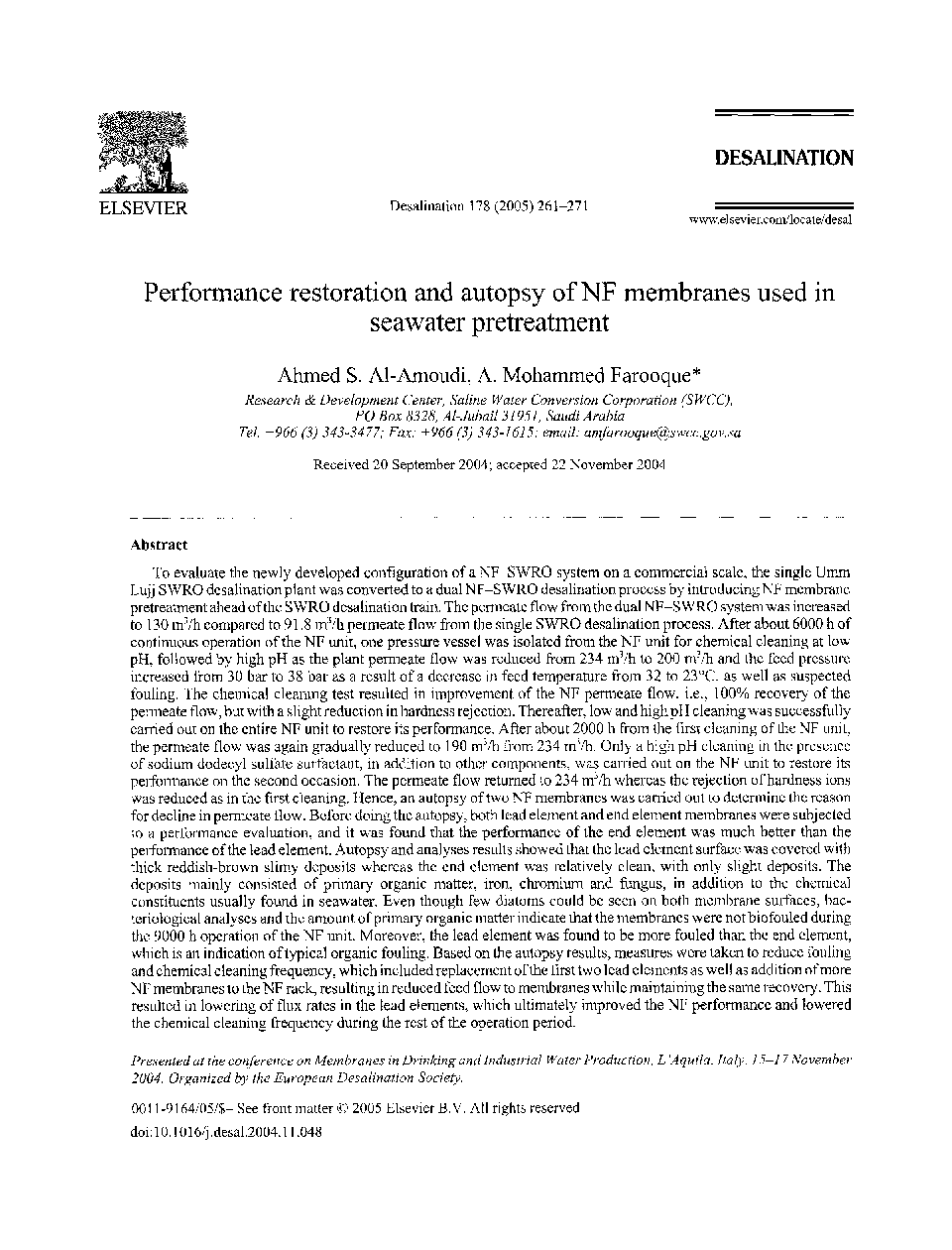| کد مقاله | کد نشریه | سال انتشار | مقاله انگلیسی | نسخه تمام متن |
|---|---|---|---|---|
| 9681152 | 1455512 | 2005 | 11 صفحه PDF | دانلود رایگان |
عنوان انگلیسی مقاله ISI
Performance restoration and autopsy of NF membranes used in seawater pretreatment
دانلود مقاله + سفارش ترجمه
دانلود مقاله ISI انگلیسی
رایگان برای ایرانیان
موضوعات مرتبط
مهندسی و علوم پایه
مهندسی شیمی
تصفیه و جداسازی
پیش نمایش صفحه اول مقاله

چکیده انگلیسی
To evaluate the newly developed configuration of a NF-SWRO system on a commercial scale, the single Umm Lujj SWRO desalination plant was converted to a dual NF-SWRO desalination process by introducing NF membrane pretreatment ahead of the SWRO desalination train. The permeate flow from the dual NF-SWRO system was increased to 130 m3/h compared to 91.8 m3/h permeate flow from the single SWRO desalination process. After about 6000 h of continuous operation of the NF unit, one pressure vessel was isolated from the NF unit for chemical cleaning at low pH, followed by high pH as the plant permeate flow was reduced from 234 m3/h to 200 m3/h and the feed pressure increased from 30 bar to 38 bar as a result of a decrease in feed temperature from 32 to 23°C, as well as suspected fouling. The chemical cleaning test resulted in improvement of the NF permeate flow, i.e., 100% recovery of the permeate flow, but with a slight reduction in hardness rejection. Thereafter, low and high pH cleaning was successfully carried out on the entire NF unit to restore its performance. After about 2000 h from the first cleaning of the NF unit, the permeate flow was again gradually reduced to 190 m3/h from 234 m3/h. Only a high pH cleaning in the presence of sodium dodecyl sulfate surfactant, in addition to other components, was carried out on the NF unit to restore its performance on the second occasion. The permeate flow returned to 234 m3/h whereas the rejection of hardness ions was reduced as in the first cleaning. Hence, an autopsy of two NF membranes was carried out to determine the reason for decline in permeate flow. Before doing the autopsy, both lead element and end element membranes were subjected to a performance evaluation, and it was found that the performance of the end element was much better than the performance of the lead element. Autopsy and analyses results showed that the lead element surface was covered with thick reddish-brown slimy deposits whereas the end element was relatively clean, with only slight deposits. The deposits mainly consisted of primary organic matter, iron, chromium and fungus, in addition to the chemical constituents usually found in seawater. Even though few diatoms could be seen on both membrane surfaces, bacteriological analyses and the amount of primary organic matter indicate that the membranes were not biofouled during the 9000 h operation of the NF unit. Moreover, the lead element was found to be more fouled than the end element, which is an indication of typical organic fouling. Based on the autopsy results, measures were taken to reduce fouling and chemical cleaning frequency, which included replacement of the first two lead elements as well as addition of more NF membranes to the NF rack, resulting in reduced feed flow to membranes while maintaining the same recovery. This resulted in lowering of flux rates in the lead elements, which ultimately improved the NF performance and lowered the chemical cleaning frequency during the rest of the operation period.
ناشر
Database: Elsevier - ScienceDirect (ساینس دایرکت)
Journal: Desalination - Volume 178, Issues 1â3, 10 July 2005, Pages 261-271
Journal: Desalination - Volume 178, Issues 1â3, 10 July 2005, Pages 261-271
نویسندگان
Ahmed S. Al-Amoudi, A. Mohammed Farooque,